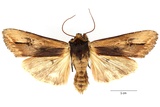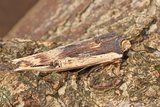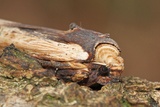Xylena vetusta (Hübner, [1813]) Species
Last modified: Oct. 16, 2025, 7:27 p.m.
An extremely rare, very local, and declining species in Belgium. During the late 90's a healthy population was present at Wenduine (WV). From 2000 onwards only a few scattered observations.
The species is generally regarded as a migrant or wanderer who sometimes manages to produce one or more new generations locally.
This species is considered Regionally Extinct according to the IUCN Red List category for Flanders 2023.
Details
- Classification
- Family: Noctuidae > Subfamily: Xyleninae > Tribus: Xylenini > Genus: Xylena > Subgenus: Xylena > Species: Xylena vetusta
- Vernacular names
- Houtkleurige vlinder (NL), Red Sword-grass (EN), L'Antique (FR), Braune Moderholzeule (DE)
- First mention in Belgium
- De Sélys-Longchamps E. 1844. Énumération des insectes Lépidoptères de la Belgique. — Mémoires de la Société royale des Sciences de Liége 2: 1–35. On page 13.
- Status
-
Native
Distribution
Bionomics
The larva is active during day and night and it pupates in a loose cocoon underground. The larva can rest several months in the cocoon prior to pupation.
Overwinters as an adult under loose bark or in other sheltered situations.
The adults are active from dusk and later they come to light and sugar.
Flight periods
The adults fly in one generation a year from mid-August to mid-October with a peak during September and after hibernation again from mid-March to late May.
Observed on
- Host plant (species):
- Myrica gale, Calluna vulgaris, Iris pseudacorus, Juncus effusus, Juncus conglomeratus and Polygonum aviculare
- Substrates:
- Deciduous trees, Shrubs, Herbaceous plants and Grasses
The larva lives on a variety of woody and herbaceous plants and scrubs like Myrica gale, Calluna vulgaris, Iris pseudacorus, Juncus effusus, Juncus conglomeratus, Polygonum aviculare etc...
Habitat
It inhabits woodland edges, riparian areas and extensive meadows and pastures, which are often more moist but not always.




